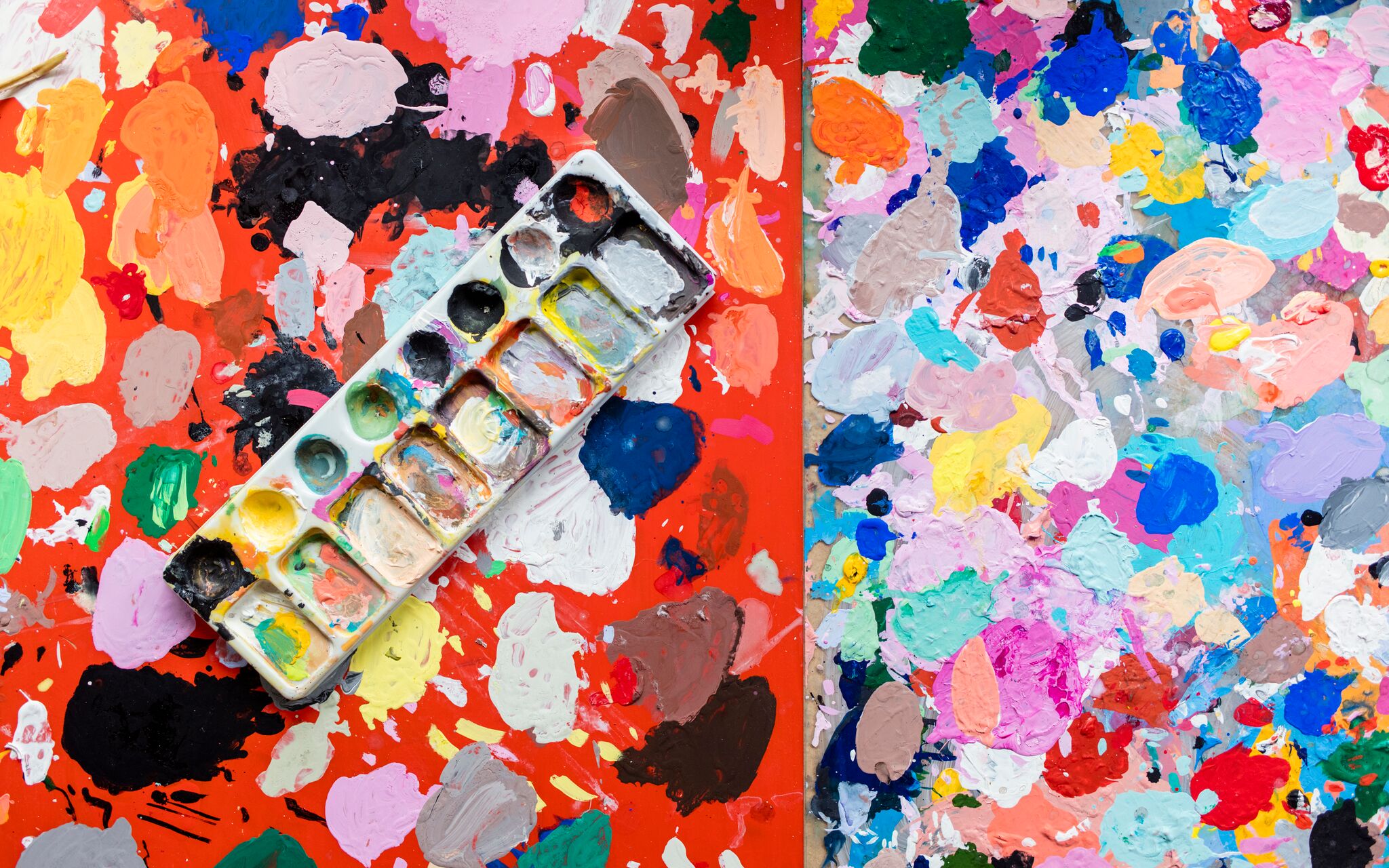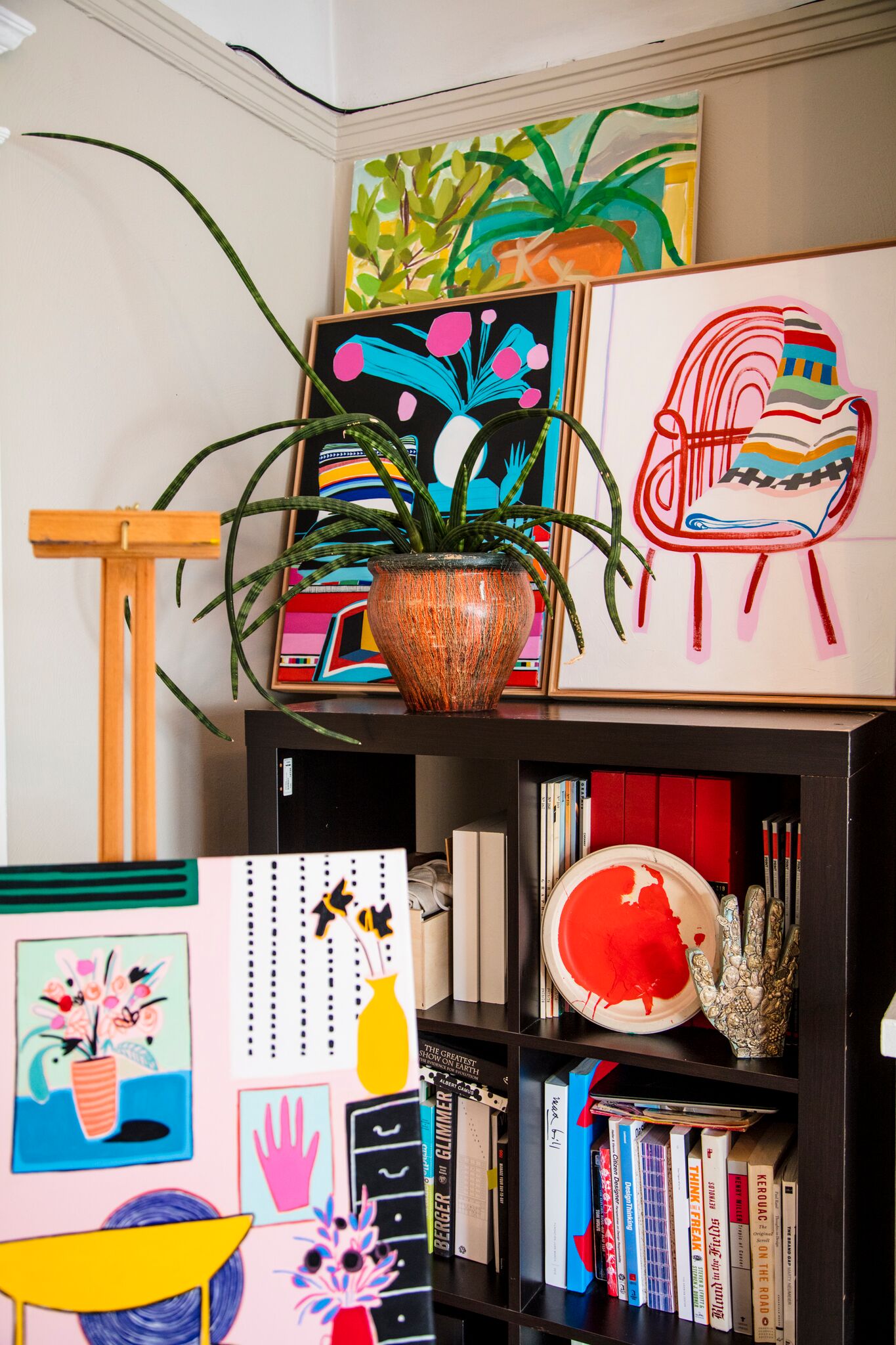Mary Finalyson: An Evolved Painter
The first time I heard the song “May I Have This Dance” by Francis and The Lights was in Mary Finlayson’s studio. Her San Francisco space is a inviting and stimulating, filled with natural light, books, paints, half-finished and finished works. The colors in the room are unlimited, with truly no hue on the color wheel left behind. After only glancing at her works, one can see Finlayson’s painting style is lighthearted yet thoughtful -- a modern take on mid century Matisse. Her works feature a wide range of pinks and purples (think Sorrow of the King but more joyous), and her textures evoke images of summer block prints and patterns. Yet, contrary to what meets the eye, the artist’s work wasn’t always quite as cheery. Read ahead for her story on becoming the creative Finlayson is now.
Written by Megan O'Sullivan. Photographed by Nicola Parisi.
Photographed by Nicola Parisi.
MO: When did you start painting?
Mary: I’ve been painting for forever, really. I studied art in university, then art education, and eventually I got a masters in art therapy and worked at the Children’s Health Council in the south bay for the last three years. I always wanted to be a full time painter, but I’m from a very pragmatic family and they were always asking questions like, what’s your job?! Had it been up to me, I probably would have painted from the get-go, but I needed to figure out a way to make money. Getting an art education and my BFA was the pragmatic approach to becoming an artist.
MO: Has your work changed a lot over the years?
Mary: My style has definitely changed a lot. My work used to be darker. Like a lot darker. I was also younger, so my work was more emotionally charged.
MO: Your work is so joyous now. What caused a change in your work?
Mary: I think i just got really tired of delving into my emotions the way I was and having them on public view. I took a step back from painting for awhile and consciously shifted my entire subject matter.
Photographed by Nicola Parisi.
MO: There is something about being young and emotionally charged that is so exhausting…!
Mary: It is! There’s a lot to figure out about yourself at that time. Especially in your early twenties. You’re always thinking about it and wondering if you’re on the right path and making the right decisions. Now that I’m a little more certain, there’s not as much anxiety. It doesn’t all go away, but I’m much more comfortable with it now.
MO: Did your work make you become more comfortable with that? How did you get there?
Mary: I think it’s about time and developing confidence. I became more self-assured with the choices I was making. I definitely don’t have the answers – I just know that as the content of my paintings changed, I became more and more comfortable with those changes.
MO: What inspired you to focus on home objects in your paintings?
Mary: I’m still really interested in the idea of narrative in art, but I wanted it to be less subjective. Objects in people’s homes carry a personal narrative, but there’s a more universal way we can look at them and translate them.
MO: What do you hope for your work to bring people? What do the colors and shapes evoke for you?
Mary: I want the works to stand on their own, to be understood through color and design and composition. I read this quote by Matisse a long time ago about his rivalry with Picasso. Picasso was like, what is your art about? And Matisse’s response was about how it’s ok for something to just be beautiful. For a work be about color and revealing beauty in the world.
Photographed by Nicola Parisi.
MO: It’s refreshing, really. I don’t think art always needs to carry a heavy meaning or emotional context for it to be art.
Mary: I think it’s important to have something light and uplifting. There are so many challenging things in this world, so why do we have to undermine art that’s not political or carrying a huge, heavy narrative? I want people to feel uplifted by my work.
MO: What do you need in your creative space to have that experience?
Mary: Music is definitely important for my process. A few of my go-tos are Gillian Welch, Bahamas, Francis and The Lights, Fleetwood Mac, Angel Olsen, Stevie Nicks. I do get sick of listening to words, so I listen to calming instrumentals as well like Bill MacKay’s guitar or audio books. I’ve listened to every David Sedaris book there is. He’s the best.
MO: Did you always know you wanted to be an artist? How did you know how to get started?
Mary: I was always creating, but finding out how I wanted to pursue being an artist took time. When it comes to pursuing what you really want to do, there’s always going to be excuses for not doing it. But even if it doesn’t make sense logistically, I think it’s really important to just start doing that thing and you’ll figure it out. That’s what makes it exciting, that’s what makes you want to keep going with it.
MO: Was there ever a time when you were unsure about it?
Mary: Oh yeah, it’s scary. Especially in a city like S.F. You have to be practical in so many ways.
But all of those odd jobs build on one another. Someone once said to me, when you’re starting over, you’re not really starting from scratch. You have all of your life experiences to inform you.
I had to take a complete leap of faith. I had an opportunity to go to Sweden to help run an art workshop, and it made no sense financially to go. I quit my job (the one that was paying my rent) and decided to just figure it out. The day I quit my job, I came home from work and checked my mail (this was in Canada). There was a letter from my university, saying that my student loan had been paid off in full because I won this lottery that I didn’t even apply for. My $25K student loan had been paid off, and in the same batch of mail, there was an envelope from my grandfather for $11k, with a note saying I want you to enjoy this while I’m still here. It lasted me for a long time – and helped pay my rent for nearly six months. That was definitely a twist of fate.
Photographed by Nicola Parisi.
MO: Wow, so I’m assuming you followed through on the Sweden trip?
Mary: Yes, and after that, I refused to take a job that wasn’t exactly what I wanted. So I was unemployed for like six months. I was doing a lot of commissions, trying to do only things that were taking me in the right direction. That was good.
MO: And in the meantime, were you applying to jobs?
Mary: Oh yeah, and that process can be demoralizing. You get denied a lot. I wrote so many cover letters. And you do get to a a point where you really just want a job so badly that you lose your conviction
MO: It’s easy to forget which job you actually want.
Mary: Which can be scary, because we wrap our identities up into what we do and feel measured by what we do. It can be hard on the ego.
MO: So what are you biggest goals right now?
Mary: I think if I can just continue to sustain doing this full time, that would be huge for me. I want to continue to produce and be productive, maybe have a couple people buy my art.
MO: What is it like being an artist in San Francisco, as compared to LA or NY?
Mary: The art world in SF is definitely different. So many people complain about it, but I think it’s great. It’s not LA or NY, but there is this community of people that support each other. We go to each other’s events and I think there is a really unique market for art here.
Everything I’ve been doing here has lead to something else. For example, showing at at West Coast Craft has lead to new connections and people contacting me to do a mural project or commissions or other things, so that’s really exciting and I just hope it keeps happening.
Photographed by Nicola Parisi.
MO: Is it hard to put yourself out there as an artist?
Mary: It can be, and it took me awhile to get to a point of being absolutely okay with being criticized. I don’t really give a shit about being turned down by something. Getting a thicker skin has helped insurmountably. I just try to focus on the opportunities that do work out and the “yes” moments I get. I think the fear of failure serves us in no way. We put way too much energy into it. We are all full of our own insecurities, but to give those powers enough credit to let them stop you from doing anything is just debilitating.
MO: If you could give one piece of advice to a creative just getting started, what would it be?
Mary: When I was getting my BFA, the lab technician for printmaking made this shirt that said something like, “Not knowing where to begin is a common form of inertia, begin anywhere.” I think that’s like what I was saying before - it doesn’t really matter where you start. You just need to start.
Photographed by Nicola Parisi.









